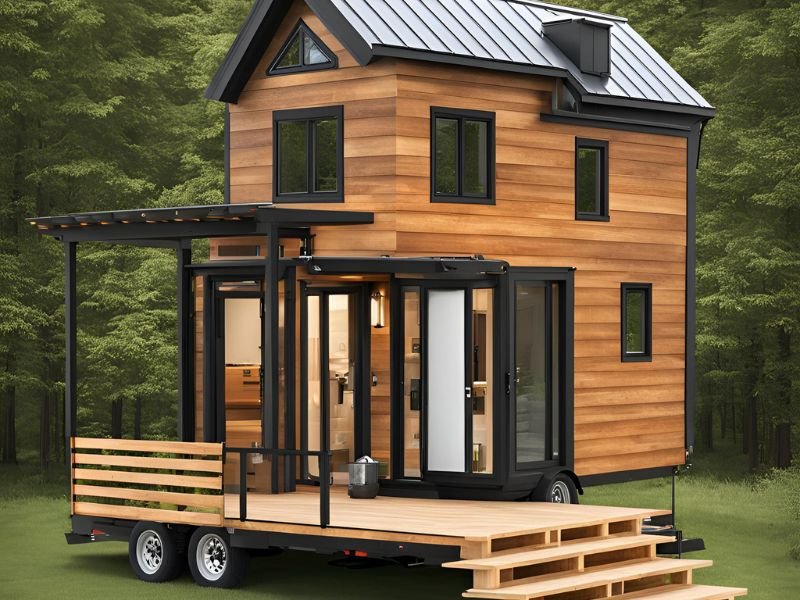Understanding zoning rules, building codes, and land use laws may prove challenging for tiny house construction. Safety compliance is essential, meeting standards for electric and plumbing. Mind property laws and setbacks, following health and safety standards. Consider community restrictions and HOA guidelines carefully. Prioritize legal obligations for successful building, and remember, a deeper understanding of these obstacles will guide your tiny house project towards success.
Key Takeaways
- Zoning regulations pose challenges like parking and square footage requirements.
- Meeting building codes for safety and standards is essential.
- Complying with land use laws and property regulations is crucial.
- Health and safety standards, including ventilation and fire safety, must be met.
- HOAs and community restrictions may impose design and construction limitations.
Zoning Regulations for Tiny Homes
Understanding zoning regulations for tiny homes can pose significant challenges for you. One key aspect is parking requirements. Some areas may mandate a certain number of parking spots per residence, which can be tricky to fulfill on a smaller lot.
Additionally, minimum square footage regulations can limit where you can place your tiny home. Some zoning laws require a minimum square footage for residences, which may be larger than the size of your tiny house. These regulations can make it difficult to find a suitable location for your tiny home within certain zoning districts.
It’s essential to research and understand these rules before starting your tiny house construction to avoid potential legal issues down the road.

Building Codes and Permits
Understanding building codes and obtaining permits is vital for guaranteeing the legality of your tiny house construction project. When beginning your tiny house journey, familiarize yourself with the permit process and make sure your structure meets all necessary code compliance standards. Below is a helpful table outlining key points to take into account when dealing with building codes and permits:
| Building Codes | Permits |
|---|---|
| Ensure safety | Obtain before |
| Meet standards | starting construction |
| Electrical wiring | Building |
| Plumbing systems | Zoning |
| Structural integrity | Inspection |
Land Use and Property Laws
To guarantee compliance with land use and property laws, it’s essential to familiarize yourself with local regulations and restrictions before commencing any tiny house construction project. Property ownership plays an important role in determining where you can build your tiny house.
Understanding the zoning laws, which dictate land development and land use within specific areas, is significant. Some areas may have restrictions on the size of dwellings or require a minimum square footage for residential structures. Additionally, you need to take into account easements, setbacks, and other property-specific regulations that may impact where and how you can place your tiny house.
Read More:
- What Are Solutions to Tiny Home Legal Issues?
- 5 Legal Solutions for Tiny Home Challenges
- 3 Best Ways to Navigate Tiny Houses Construction Laws
Health and Safety Standards
Prior to commencing the construction of your tiny house, make sure to comply with health and safety standards to prioritize the well-being of occupants and meet legal requirements. It is essential to adhere to health regulations and safety requirements to guarantee a safe living environment within your tiny house. Health regulations encompass aspects such as proper ventilation, sanitation facilities, and safe drinking water. Safety requirements involve fire safety measures, structural stability, and emergency exits to protect against potential hazards. By following these standards, you not only safeguard the health and safety of those residing in the tiny house but also ensure compliance with legal obligations.
| Health Regulations | Safety Requirements |
|---|---|
| Proper ventilation | Fire safety measures |
| Sanitation facilities | Structural stability |
| Safe drinking water | Emergency exits |
HOA and Community Restrictions
Before you proceed with building your tiny house, be aware of potential legal hurdles posed by Homeowners Associations (HOAs) and community restrictions that may impact your construction plans. HOAs often have specific guidelines regarding the size, appearance, and placement of homes within their jurisdiction. These guidelines can restrict the construction of tiny houses or require adherence to certain design standards that may not align with your vision.
Additionally, community covenants can impose further limitations on the type of structures allowed, making it important to review these restrictions before starting your project. Violating HOA guidelines or community covenants could result in fines, legal actions, or the requirement to modify or remove your tiny house. Understanding and complying with these regulations is crucial to avoid potential setbacks during and after construction.
Conclusion
As you navigate the legal obstacles of tiny house construction, keep in mind that over 70% of US cities have restrictions on tiny homes. Understanding zoning regulations, building codes, and property laws is essential to successfully building your dream tiny house.
Remember, knowledge is power when it comes to overcoming legal challenges in the tiny house movement.
Read More:
